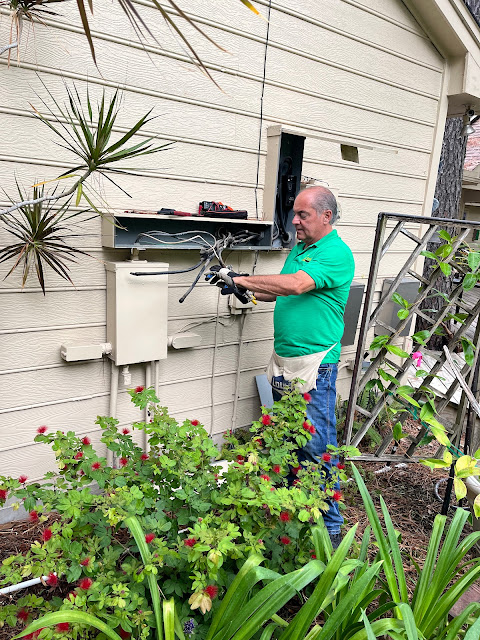It's Time To Ditch The Extension Cords And Add A New Circuit Or Outlet Installed By Electricians In Spring TX
Is it time to ditch the extension cords? You could be
overloading them causing a strain on your electrical system.. Speak to the electricians in Spring, Texas about this. Not to mention
stumbling and tripping all over them. Oh, and there’s the worst, accidentally
unplugging them. Using too many extension cords can indeed be dangerous. Here
are several reasons why:
1. **Overloading Circuits**: Extension cords are only
designed to handle a certain amount of electrical current. Plugging too many
devices into one extension cord can overload it, causing overheating and
potentially starting a fire. Schedule an electrician in
2. **Tripping Hazards**: Extension cords stretched across
walkways or under carpets can create tripping hazards, especially in areas with
high foot traffic. Tripping over cords can lead to injuries and accidents.
3. **Damage and Wear**: Extension cords can become frayed or
damaged over time, especially if they're repeatedly stepped on or rolled over
by furniture. Damaged cords can expose wires, increasing the risk of electrical
shock or fire.
4. **Poor Connections**: Loose connections between the
extension cord and the outlet or between the cord and the device can create
sparks and increase the risk of fire.
5. **Inadequate Protection**: Extension cords are not
designed for permanent use or for powering major appliances or heavy-duty
equipment. Using them in this way can lead to overheating and fire hazards. Check the factory rating on the cord or speak with an electrician in
To avoid these dangers, it's important to use extension cords responsibly and sparingly. Whenever possible, it's better to install additional outlets or circuits to accommodate your electrical needs rather than relying on extension cords. If you find yourself needing extension cords frequently, consider consulting with qualified electricians in Spring, TX to assess your home's electrical system and make necessary upgrades for safety and convenience.
Adding a new electrical circuit involves several steps and
might require a professional electrician, especially if you're not familiar
with electrical work. Here's a general guide on how to add a new electrical
circuit:
1. **Assessment**: Evaluate your electrical needs and
determine the appropriate location for the new circuit. Consider the electrical
load requirements of the devices you plan to connect to it.
2. **Check Local Codes**: Make sure to comply with local building codes and regulations regarding electrical work. You may need to obtain permits before starting the project. A professional electrician in Spring, TX will be able to help with this.
3. **Plan the Circuit**: Determine the circuit's voltage
(120V or 240V), amperage rating, and the type of wiring (typically 14-gauge for
15-amp circuits and 12-gauge for 20-amp circuits).
4. **Choose a Circuit Breaker**: Select a circuit breaker of
appropriate size for the new circuit. This will depend on the electrical load
and wire size. An electrician will help take the guess work out of this to ensure safety.
5. **Gather Materials**: Purchase the necessary materials
including wires, junction boxes, outlets or switches, circuit breaker, and any
other components required for the installation.
6. **Turn Off Power**: Shut off power to the area where
you'll be working at the main electrical panel. Use a voltage tester to ensure
that the power is off before proceeding.
7. **Run the Wiring**: Route the wiring from the electrical
panel to the location of the new outlet or switch. Use appropriate wiring
methods and secure the cables properly. The route of the wiring is important per building codes. Speak with electricians in
8. **Install Junction Box**: Install a junction box at the
endpoint of the wiring run. This will serve as the connection point for the outlets
or switches.
9. **Connect Outlets/Switches**: Wire the outlets or
switches to the junction box according to the circuit diagram. Follow proper
wiring practices and use wire nuts to secure connections.
10. **Connect to Electrical Panel**: Connect the other end of the wiring to the circuit breaker in the electrical panel. Make sure the connections are tight and secure. Working in your electrical panel can be dangerous. Have an electrician in Spring, TX handle this to make sure the job is done right!
11. **Test the Circuit**: Turn the power back on and test
the new circuit using a circuit tester. Ensure that all outlets or switches are
functioning properly.
12. **Finalize and Secure**: Once everything is tested and
working correctly, finalize the installation by securing all wires, closing up
junction boxes properly, and labeling the new circuit at the electrical panel.
If you're not comfortable with any aspect of this process or
if it involves significant modifications to your home's electrical system, it's
best to hire licensed Electricians Spring TX to ensure safety and compliance with
electrical codes. Logo Electrical Services has the electricians available for any electrical installation you throw at them.


Comments
Post a Comment